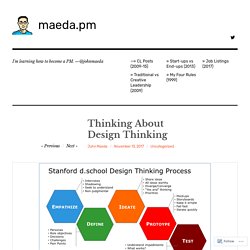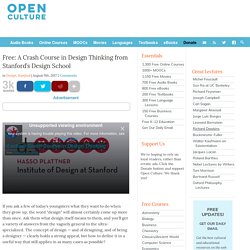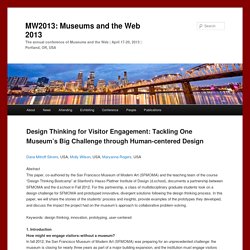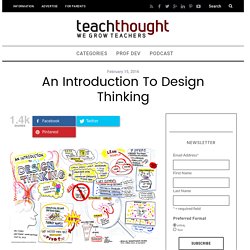

On Flipboard. On Flipboard. This 10-Minute Routine Will Increase Your Clarity And Creativity. “Your subconscious mind works continuously, while you are awake, and while you sleep.” — Napoleon Hill Your subconscious never rests and is always on duty because it controls yourheartbeat, blood circulation, and digestion. It controls all the vital processes and functions of your body and knows the answers to all your problems. One-Minute Papers: A Way to Further Design Thinking. Connecting Design Thinking to Your Area of Expertise Many of us have sat through long lectures believing the material did not connect to us at all.

This should not be the case with design thinking, a process that involves rethinking and reframing problems to make things easier, more streamlined or different. However, many people view design thinking as an insular activity that does not mesh with their specific domain of expertise. Thinking About Design Thinking – maeda.pm. I had a great morning convo with my Automattic Design colleague Mike Shelton that took me down the rabbit hole of successive Google image searches for design thinking and design sprinting diagrams: Uhhhhh … I kind of regret it now.

It’s like Baskin Robbins “31 Flavors of design thinking” out there! A simple way to think of design thinking is that it is about designing inclusively. Remember your Vitamin E(mpathy), always! —JM. How to solve problems like a designer. When Tim Brown joined the design consulting firm IDEO in 1987, the company’s repertoire was pretty straightforward.

They designed products: the first computer mouse for Apple, the first laptop computer for GRiD Systems, a personal digital assistant for Palm, and more. But, somewhere between then and now, the company changed direction. Take a Free Crash Course in Design Thinking from Stanford's Design School. If you ask a few of today's youngsters what they want to do when they grow up, the word "design" will almost certainly come up more than once.

Ask them what design itself means to them, and you'll get a variety of answers from the vaguely general to the ultra-specialized. The concept of design — and of designing, and of being a designer — clearly holds a strong appeal, but how to define it in a useful way that still applies in as many cases as possible? One set of answers comes from the 90-minute "Crash Course in Design Thinking" above, a production of Stanford University's Hasso Plattner Institute of Design, or d.school.
The Interaction Design Foundation defines design thinking as "an iterative process in which we seek to understand the user, challenge assumptions we might have, and redefine problems in an attempt to identify alternative strategies and solutions that might not be instantly apparent with our initial level of understanding. " Related Content: How Design Thinking Helps Students Take Action - Global Learning. Scaffolded prototyping ideas.. of mockups, funky & dark horses.
Melissa Pelochino. Melissa knows how it feels to take a 3 a.m. phone call and hear a grade-school student’s voice on the other end of the line.

She has looked in the eyes of a child who knows they have been labeled a failure. An education professional with more than a decade of experience in Title 1 schools, Melissa has found teaching to be a way of life. Beyond her work as an educator, she’s also a d.school success story. In 2007, Melissa was a reading specialist at East Palo Alto Academy working with 7th and 8th graders. How Might We provide educators with concrete design thinking activities for the classroom while still highlighting the mindsets behind them? We considered feedback seriously before designing our third, of four, d.home Team experiences in our d.home Team series.

We looked at videos, interview notes, feedback surveys and “next step” post-its to try to understand what was resonating with our educators from our past experiences together and what was not. It was clear from the data that the easiest and most popular take-aways from days one and two were the concrete, tangible, activity-based experiences they could easily replicate in classrooms. Questions around how to merge our participants’ need for the concrete with our desire to experiment around teaching mindsets is what drove our team conversations and debates for the next several days. Here is what we tried… Day 3 – Mindsets into Action.
Design Thinking for Visitor Engagement: Tackling One Museum’s Big Challenge through Human-centered Design. Dana Mitroff Silvers, USA, Molly Wilson, USA, Maryanna Rogers, USA Abstract This paper, co-authored by the San Francisco Museum of Modern Art (SFMOMA) and the teaching team of the course “Design Thinking Bootcamp” at Stanford’s Hasso Plattner Institute of Design (d.school), documents a partnership between SFMOMA and the d.school in Fall 2012.

Design Thinking for Visitor Engagement: Tackling One Museum’s Big Challenge through Human-centered Design. 2016SFA sen mgmt3500. 2017SSP sen mgmt3500. A Better Way - DEEP design thinking. Storytelling Online Course - IDEO U. Collective Action Toolkit. DTtoolkit. An Introduction To Design Thinking - An Introduction To Design Thinking by Friederike Geiken, Member of Women Who Code The term design thinking gets bandied around a lot these days, but what does it really mean?
